There are so many different types of worms that love to hang out in trees that it’s tough to keep track. Just a few of the different types of worms in trees include bagworms, Catawba worms, apple tree worms, Christmas tree worms, army worms, and catalpa tree worms. Please continue reading to learn all about these tree-loving worms.
Bagworms
If your home is surrounded by trees, chances are there are bunches of little bags hidden in the bark of the tree trunks. Inside may be hundreds and possibly 1,000 eggs containing bagworms (Thyridopteryx ephemeraeformis). The bagworm larva prefer red cedar and arborvitae above all as well as apple, birch, black locust, cypress, elm, juniper, oak, pine, poplar, spruce, and sycamore. The bagworm occurs mostly from New England to Nebraska and south through the state of Texas.
Inside of the bag, which may be camouflaged with foliage, bark, and other debris, the larva is tan or brown with black spots. Once it emerges, the larva is black. It spins down on a silk string in search of a host plant. In some cases, the larva never makes it all the way down on the string, but rather it is picked up by the wind and whisked off to nearby plants. Once the larva has found a host plant either on its own or via the wind, it begins to spin a new bag over its body. The larva feeds and grows inside of the bag. It feeds by sticking its head out to eat, and then it retracts. It protects itself from any perceived threats by retracting into the bag and holding it shut.
By around mid-August, the bagworms mature and they migrate to another area in search of a sturdy host or structure. After the move, the larva pupates. This is the non-feeding stage where the bagworm begins to transform into its adult form. The female bagworm transforms into a wingless moth, which actually looks much like its larva and the male transforms into a winged moth.
Because the bagworm goes unnoticed until it is mature, it is tough to control. If there happens to be pesticide residue on surrounding foliage, the mature larvae may pupate early. Bagworms have few known predators and even fewer known parasites, so some of the most effective control measures often involve chemicals.
According to the Ohio State University Extension Center’s Entomology Department, there are four effective control options including:
- Insecticide Sprays
- Timed Sprays Using Degree-Day Emergence
- Mechanical Hand Picking
- Bacterial Spray Bacillus thuringiensis (Bt)
*Insecticide Sprays
Stomach insecticides are very useful for control of bagworms. Remember that the plant foliage is to be thoroughly covered because the larvae are protected from contact by being in the silk bag. Again, early sprays against young larvae are more effective than later applications. Products registered for bagworm control are: acephate (Orthene), bendiocarb (Ficam, Turcam)(*), bifenthrin (Talstar), carbaryl (Sevin), chlorpyrifos (Dursban), cyfluthrin (Tempo)(*), diazinon, dimethoate (Cygon), fluvalinate (Mavrik)(*), malathion, nicotine sulfate, pyrethrum, permethrin (Pounce)(*), rotenone and trichlorfon (Dylox, Proxol)(*).
*Timed Sprays Using Degree-Day Emergence
Using a base temperature of 14.4 degrees C (57.9 degrees F) the median first emergence is 380 DD base 14.4 degrees C (716 DD degrees F) and the median last emergence is 572 DD base 14.4 degrees C (1062 DD degrees F). Allow for an extra week of ballooning after the last emergence mark has been reached before applying Bt or an insecticide. A less precise degree-day model uses a 50 degrees F base, which calculates last emergence around 900 DD units.
*Mechanical Hand Picking
If the bags are few in number and easily reached they may be picked off the plant and squashed. This can be done easily in the late fall when deciduous foliage has been dropped or the bits of plant material on the bags turn brown and can be easily located on evergreens. Be sure to cut the attachment silk band so that the branch will not be girdled in the future.
*Bacterial Spray Bacillus thuringiensis (Bt)
Bt is effective against bagworms if it is used against young larvae. Applications should be made at the end of June after all the eggs have hatched and the larvae are through ballooning.
*From Ohio State University Extension Center, Entomology Department, D.J. Shetlar.
Catawba Worms
The Catawba worm is the larva of the sphinx moth. This black and yellow caterpillar infests the catalpa tree and feeds off of the tree leaves. It is considered a pest mainly because the catalpa tree is popular for it’s magnificent wood that is used for fine cabinetry. The catalpa tree belongs to the family Bignoniceae. It is classified as Catalpa bignonioides.
“Catalpa Tree” is the common name of a tree of the bignonia family. The species is cultivated as an ornamental shade tree, growing to up to 40 feet tall (12 m). Native to the United States, the catalpa tree has silver-gray bark, widely spread branches, and large, pale-green, heart-shaped leaves. The catalpa tree flowers are white, tinged, and dotted with violet or purple. Long, beanlike pods called “Indian beans,” that sometimes hang on the limbs all winter, succeed them. The seeds are winged. Catalpa wood, even in its rawest form, is light and fine and useful in cabinetwork.
Also called “Catalpa” worms, the Catawba worm has both friends and enemies. Lovers of the catalpa tree may employ several methods to destroy these “pests” while fishermen will plant catalpa trees specifically to attract Catawba worms. Fishermen prize these worms as fish bait due to their tough skin and juicy bodies. Catawba worms can even be frozen for fish bait and used at a later time. The Catawba worm is considered excellent bait for catfish. In addition to their usefulness to fishermen, Catawba worms are prized for their attractiveness in many places across the U.S., such as Georgia. While some larvae are black with yellow stripes running down the sides, others are white with black splotches. Catawba worms also have a major distinctive feature – it’s tail. The Catawba worm has a tail-like horn on its rear end.
Catalpa tree lovers prefer to avoid an infestation at any cost or extinguish it, but it is believed that while the Catawba worm can defoliate the catalpa tree up to three times each summer, there appears to be no major consequences to the tree.
An infested catalpa tree can have hundreds, if not thousands of larvae. In fact, if one were to stand under a catalpa tree filled with Catawba worms, it would be like standing in a drizzling rain, except the “rain” would be a steady drizzle of falling frass or rather, caterpillar poop.
Once the Catawba worm has fed to capacity, it drops from the tree and pupates in the soil below. The following spring, the Catawba worm will emerge as a hummingbird moth — the catalpa sphinx moth. The moth isn’t quite as colorful or unique as the larva. They are dull gray and nocturnal, so chances are you will never actually see one.
If you are convinced that the Catawba worm is ruining your catalpa tree, there are several ways to get rid of them. Preventative measures include insecticides such as Ortho Grub-B-Gon Max, Merit, Arena, Mach2, and Season-Long Grub Control. Bacillus thuringiensis (Bt) is also effective. Bt is a live microorganism that kills certain insects. It is used to kill unwelcome insects in forests, agriculture, and urban areas. Bt and other insecticides may be purchased online or at a variety of home and garden retailers.
Apple Tree Worms
There are a number of worms that crave apples just as much as us humans. They come in all shapes and sizes and some cause more damage than others. But two of the most common types of apple tree worms are the “apple maggot” and “codling moths.”
About Apple Maggots
Apple maggots are white worms that eat the flesh inside of maturing apples. These are among the toughest worms to detect from the outside. The apple maggot is the larva of the apple maggot fly. They are white or yellowish in color and they can grow up to ¼ of an inch long. The adult apple maggot fly is also ¼ of an inch long. The adult apple maggot is quite easy to spot due to its color. It has yellow legs and it is black in color. It also has yellow markings across its abdomen and bands that appear in a zigzag pattern across the wings.
It only takes a second or two for the apple maggot to lay a bundle of eggs on an apple or even a pear. It lay’s its eggs in punctures in pear or apple skin.
Apple Maggot Prevention
Apple maggots can ruin the apples in your apple tree if you don’t stop them before they start. One of the best ways to control apple maggot populations in and around your apple trees is to prevent the fly from laying eggs in the first place. This can be accomplished by using sticky traps. Sticky traps are available at just about any store that sells camping gear, home and garden products, super stores, and even drugstores. Sticky traps are made from either a red ball or a yellow rectangle. This ball or rectangle is covered with a sticky material that traps the fly with even the slightest touch. You should hang the sticky traps in and around your fruit trees in late June. They should remain in place until after harvest. It’s best to use at least two traps per tree for a dwarf or semi-dwarf and at least four traps for standard trees. It is important to keep the sticky traps clear of surrounding branches and discard all fallen fruit immediately.
About Codling Moths
You can always tell if you have a codling moth infestation just by looking at the crevices in the bark of your apple trees. The codling moth spins its cocoon right in the crevices of apple trees. The codling moth larva is pink in color with a brown hear and it is around one inch long. The adult codling moth is a grayish brown color with brown lines on its forewings. It has pale, fringed hind wings with a wingspan of around ¾ of an inch. The adult lays white, flat eggs in a number of places such as on fruit buds, leaves, or twigs. The larvae of codling moths make their way into apples through tunneling. Once they are just inside the apple, they continue to tunnel their way through, eating as they tunnel along.
How to Control Codling Moths
There are several effective methods of controlling codling moths. In late winter or early spring you can spray dormant oil on trees prior to leaf budding. This will suffocate the eggs. Once the blossoms begin to open, meaning once they “show pink” called “open cluster,” position sticky traps with pheromone lures to catch the moths. If you notice a dozen or more moths caught in a single trap during the 10 to 14 days after bloom time, use Ryania, a botanical insecticide made from the ground stems of Ryania speciosa, a native plant of tropical America, in a spray as the blossom petals start to fall. To kill the newly hatched larva, spray Bacillus thuringiensis (BT), a live microorganism that kills insects, and light horticultural oils every seven to 10 days later in the season.
You can also control codling moths by attracting parasites of codling moths. Simply plant butterfly weed (Asclepias tuberosa) nearby. Butterfly weed hosts codling parasites.
Christmas Tree Worms
Christmas tree worms (Spirobranchus giganteus) are found on coral reefs in tropical waters around the world. Christmas tree worms are not dangerous to humans and both male and female Christmas tree worms exist. They reproduce by casting their eggs and sperm directly into the water. The eggs are fertilized in the water then develop into larvae that settle on coral heads and burrow into the coral.
Christmas tree worms can be quite pleasing to the eye. It is Christmas tree-shaped with dazzling twin spirals of plumes used for feeding and respiration. This serpulid tube-dwelling worm is one of the most widely recognized sedentary polychaete worms in the world. The cone-shaped worm comes in many colors including orange, yellow, blue, and white. With an average 3.8 cm in span, Christmas tree worms are small in size but because of their beauty, shape, and color, they are easily spotted. Their colorful plumes, or tentacles are used for respiration and for passive feeding on suspended food particles and plankton in the water. Though the plumes are visible, most of the worm is anchored in its burrow that it bores into a live calcareous coral.
If you approach a Christmas tree worm, they will sense your presence immediately. They are extremely sensitive to disturbances and will rapidly retract into the burrow at the slightest touch or passing shadow. They typically re-emerge a minute later, very slowly, to test the water before fully extending their plumes again.
Christmas tree worms feed by using radioles. Radioles are hair-like appendages that circle outward from the central spine to catch phytoplankton floating in the water column. Once the worm catches the food, it is then passed down the food groove by the feeding pinnules. The feeding pinnules are ciliary tracts or tiny hair-like extensions on the surface of cells that generate water currents to move food or mucus. The food particles are sorted, but larger particles are discarded. Any sand grains that the worm collects are directed to storage sacs to be used later for tube building.
Christmas Tree Worms and your Home Aquarium
While Christmas tree worms make a beautiful addition to any home aquarium, most die within few months due to the improper care and lack of natural surroundings. To give your Christmas tree worms the best chance at a long life, follow the recommendations below.
Recommended Water parameters for keeping Christmas tree worms
PH: 8.2-8.3
Temperature: 77-79F
Ammonia: zero
Nitrite: zero
Nitrate: zero
Specific Gravity: 1.021-1.026
Dissolved Oxygen: 7-8 ppm
Calcium: 400-450 ppm
Phosphates: zero
KH: A natural seawater level of 7 dKH
Redox Potential: 350-400mv
For pictures of Christmas tree worms and a video of a Christmas tree worm retracting click here to visit Reefbuilders.com.
Army Worms
Army worms are pests that typically infest fruit trees and vegetable crops. In addition to corn crops, army worms will feed off of cotton, peanut, and alfalfa sprout crops. Army worms are active at night, so to see one would be a rare occurrence. While army worms are considered pests overall, they are particularly troublesome in fruit trees and orchards that may be covered in leaves and excessive overgrowth. Because overgrowth keeps the area dark, it encourages early worm development. It is easy to conclude that you have an army worm infestation by simply examining the condition of the leaves and fruit on trees. The surface of the fruit will be eaten away and foliage will appear tattered or stripped.
Army worms can occur in large numbers in late districts. They can occur without warning and they can do major damage to crops in a short period of time. The army worm climbs into trees in the spring when buds are developing. They will destroy all or part of the blossom clusters and newer leaves. Although this is not a regular occurrence, later generations of army worms will attack fruit and foliage all the way up to harvest.
The army worm lives mostly in the southern United States, South America, some islands of the West Indies, and the tropics of Central America. The army worm can only survive the winter in the tropics and the warm Gulf areas of the U.S. The adult army worm migrates each year to the northeastern part of the United States between early and late July.
The army worm is about 1-1/2 inches long when it is full grown. They are can range in color from light tan or green to black. The army worm has a prominent inverted Y on the front of its head. The adult moth has a wingspan of about 1-1/2 inches and the hind wings are grayish white. The first pair are dark gray mottled with lighter and darker patches. The adult moth also has a white spot near its extreme tips. Much like its larvae, the moth is mainly active at night.
The best way to prevent major infestations is by controlling ground vegetation and overgrowth. To determine if you have an army worm problem check for stripped foliage or buds. Begin looking for cutworms at night to see if they are responsible for the damage. In general, serious damage occurs only in areas with overgrown ground covers.
Army worms also have natural predators, so in many cases, you won’t have to do anything to control populations. Insecticides should be used as a last resort. It is important to keep in mind that a population level of more than 15 percent of damaged plants in the plants early stages is cause for action.
Catalpa Tree Worms
The catalpa worm is the larva of the sphinx moth. This black and yellow caterpillar infests the catalpa tree, feeding mainly off of the trees leaves. It is considered a pest mainly because the catalpa tree is popular for it’s magnificent wood, which is used for fine cabinetry. The catalpa tree belongs to the family Bignoniceae. It is classified as Catalpa bignonioides.
“Catalpa Tree” is the common name of a tree of the bignonia family. The species is cultivated as an ornamental shade tree, growing to up to 40 feet tall (12 m). Native to the United States, the catalpa tree has silver-gray bark, widely spread branches, and large, pale-green, heart-shaped leaves. The catalpa tree flowers are white, tinged, and dotted with violet or purple. Long, beanlike pods called “Indian beans,” that sometimes hang on the limbs all winter, succeed them. The seeds are winged. Catalpa wood, even in its rawest form, is light and fine and useful in cabinetwork.
Also called “Catawba” worms, the catalpa worm has both friends and enemies. Lovers of the catalpa tree may employ several methods to destroy these “pests” while fishermen will plant catalpa trees specifically to attract catalpa worms. Fishermen prize these worms as fish bait due to their tough skin and juicy bodies. Catalpa worms can even be frozen for fish bait and used at a later time. The catalpa worm is considered excellent bait for catfish. In addition to their usefulness to fishermen, catalpa worms are prized for their attractiveness in many places across the U.S., such as Georgia. While some larvae are black with yellow stripes running down the sides, others are white with black splotches. Catalpa worms also have a major distinctive feature – it’s tail. The catalpa worm has a tail-like horn on its rear end.
Catalpa tree lovers prefer to avoid an infestation at any cost or extinguish it, but it is believed that while the catalpa worm can defoliate the catalpa tree up to three times each summer, there appears to be no major consequences to the tree.
An infested catalpa tree can have hundreds, if not thousands of larvae. In fact, if one were to stand under a catalpa tree filled with catalpa worms, it would be like standing in a drizzling rain, except the “rain” would be a steady drizzle of falling frass or rather, caterpillar poop.
Once the catalpa worm has fed to capacity, it drops from the tree and pupates in the soil below. The following spring, the catalpa worm will emerge as a hummingbird moth — the catalpa sphinx moth. The moth isn’t quite as colorful or unique as the larva. They are dull gray and nocturnal, so chances are you will never actually see one.
If you are convinced that the catalpa worm is ruining your catalpa tree, there are several ways to get rid of them. Preventative measures include insecticides such as Ortho Grub-B-Gon Max, Merit, Arena, Mach2, and Season-Long Grub Control. Bacillus thuringiensis (Bt) is also effective. Bt is a live microorganism that kills certain insects. It is used to kill unwelcome insects in forests, agriculture, and urban areas. Bt and other insecticides may be purchased online or at a variety of home and garden retailers.
All About Worms is always free, always reader-supported. Your tips via CashApp, Venmo, or Paypal are appreciated! Receipts will come from ISIPP Publishing.



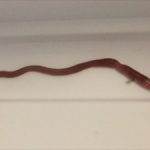
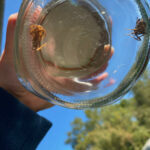
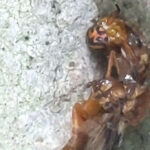
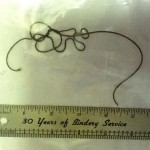
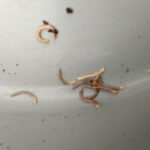

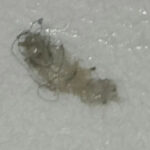
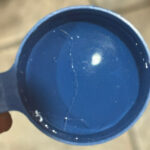

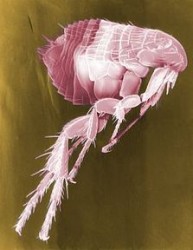
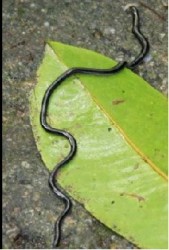



We have huge Elm tree in our front yard. While planting flowers around bottom of landscaped tree I found worms a little over an inch long, dark fuzzy black color, and white rectangular spots in middle of back. We have rocks around the bottom of tree and also landscaped around our house. Not sure what is causing this, but have considered “Elm Disease” of our tree. My husband has a car parked in our driveway, also, and I have found these worms on top of the car. Need to find out problem, and take care of it asap.
I have worms in my Bottle tree (Sterculia diversifolia). They leave a series of holes around the trunk and branches–almost like girdling. I live in the Southwestern U.S. (Coachella Valley) and this is the first time I have seen this type of worm.
Does anyone have info on this?
these worms appear early spring and become an infestation. They crawl up the tree and are active at night. Its like the whole ground is moving. They look like large brown maggots. How can i get rid of them. This is the second year I’v noticed them.
I have white worms in clusters in web like sacks in my ornamental tree – what are they and how can I get rid of them – come every year
We have about 1 inch green worm with black heads eating all the needles of our pine trees. What type of worms are these and what spray will get rid of these pests?
Hi, we have a worm (?) in our Aspen tree, can’t seem to find any pics to identify it. The colors look red and black, it’s in the top of our tallest tree and hard to really see but there are several! Any ideas? We are in the SW region of Colorado.
Thanks, Mary
Debbie, we would be happy to help you if you can submit a picture and request through the link on the right-hand side of the page.
I have some type of worms eating the leaves on mt apple tree. They are roughly one inch long, blackish green, orange and reddish. They seem to attack the leaves in clusters with perhaps 10 to 12 worms per leaf.
Can you help me find out what they are and what to use to get rid of them. I live in the middle of Saskatchewan, Canada.
Like to know if there are male and female worms .